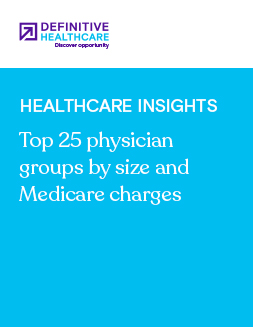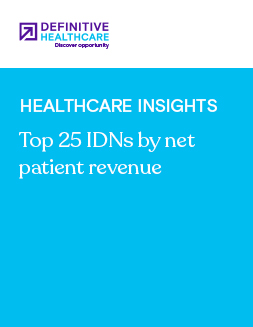Healthcare Insights
Top 25 home health corporations by total patient volume
Home health agencies provide the care necessary to support patients with chronic illness or other disabilities in their homes rather than in hospitals or skilled nursing facilities. These may be publicly or privately owned, but many of the largest providers in home health are private corporations.
In recent years, we’ve seen a theme of large payors, particularly Medicare Advantage plans, looking to acquire home health companies to build home-based services. With the continued rise in seniors who wish to age in place, but require skilled care, owning home health assets helps payors coordinate care for their members and reduce overall costs.
Home health care services are usually delivered by home health aides and nurses, and may include wound care, medication administration, drug infusion therapy, or patient caregiver education, among others.
Using data on more than 1,000 active home health agencies, we’ve compiled a list of the largest home health companies ranked by their total patient volumes in 2024.
| Rank | Home health agency name | State | Total patients | Explore dataset |
|---|---|---|---|---|
| 1 | Matrix Medical Network | AZ | 371,679 | Explore |
| 2 | United HomeCare | FL | 159,196 | Explore |
| 3 | Western Home Health Inc | CA | 90,955 | Explore |
| 4 | CenterWell | NC | 60,024 | Explore |
| 5 | Pinnacle Home Care | FL | 55,906 | Explore |
| 6 | Allina Health | MN | 54,854 | Explore |
| 7 | CenterWell | FL | 49,381 | Explore |
| 8 | Wellstar Health System | GA | 46,398 | Explore |
| 9 | Amedisys Inc | GA | 41,562 | Explore |
| 10 | UnityPoint Health (FKA Iowa Health System) | IA | 40,622 | Explore |
| 11 | LHC Group | FL | 38,543 | Explore |
| 12 | Advocate Health | WI | 38,203 | Explore |
| 13 | Johns Hopkins Medicine | MD | 38,028 | Explore |
| 14 | Froedtert ThedaCare Health Inc | WI | 36,095 | Explore |
| 15 | LHC Group | NM | 35,374 | Explore |
| 16 | CenterWell | SC | 35,295 | Explore |
| 17 | Corewell Health (FKA BHSH System) | MI | 34,156 | Explore |
| 18 | Cleveland Clinic Health System | OH | 33,558 | Explore |
| 19 | At Home Medical | NJ | 32,133 | Explore |
| 20 | LHC Group | TN | 31,836 | Explore |
| 21 | Enhabit Home Health & Hospice | TX | 30,874 | Explore |
| 22 | Cook Childrens Health Care System | TX | 30,631 | Explore |
| 23 | LHC Group | MS | 28,605 | Explore |
| 24 | AccentCare | TX | 27,835 | Explore |
| 25 | University of Pittsburgh Medical Center (AKA UPMC) | PA | 27,825 | Explore |
Fig. 1 – Data is from Definitive Healthcare’s LongTermCareView product. Data is accurate as of October 2025.
Which home health agencies had the highest patient volumes in 2024?
The list is led by Matrix Medical Network in Arizona, which serves an exceptionally high number of patients (371,679)—more than double that of the next largest agency, United HomeCare (159,196). The top three home health companies account for roughly half of all patients in the top 10, showing a steep concentration of volume at the top.
Rounding out the top includes the agencies Western Home Health, CenterWell, and Pinnacle Home Care, which serve between 50,000 and 90,000 patients, indicating a sharp drop-off after the top performer but still substantial reach.
While the list includes representation from across the country, there’s a clear density in states with large elderly populations—Florida, Texas, California, and Georgia in particular. Florida stands out as a major hub for home health activity, with four providers in the top 25. The Southeast region overall (FL, GA, SC) hosts several high-volume providers, reflecting both demographic trends (aging populations) and strong post-acute care networks.
Finally, while the top three agencies command an outsized share of patients, the remainder of the list demonstrates a long tail of strong regional providers. Most home health companies in the lower half of the top 25 treat between 30,000 and 60,000 patients, indicating a consistent but localized market presence.
How home health agency data can fuel your growth strategy
Home health care data can be a powerful asset for organizations looking to build more effective commercialization strategies across healthcare, life sciences, medtech, and software sectors.
To start, market segmentation and targeting become far more precise when grounded in agency data. Metrics such as total patient volume, state distribution, and ownership structure (independent versus system-affiliated) reveal where demand for home-based services is strongest.
Home health care data also enables solution alignment and value messaging. By examining each agency’s size, patient population, and affiliations with health systems or payors, companies can determine which pain points are most relevant to their audience.
Finally, this data allows commercial teams to measure and optimize go-to-market effectiveness. By mapping performance metrics against agency data such as geography and patient volume, organizations can identify where outreach is most successful and where adjustments are needed.
Who qualifies for home health care services?
In order to qualify for Medicare Part A or Part B coverage of home health services, a patient must be under the care of a doctor and require (as certified by a doctor) skilled nursing care beyond drawing blood, and/or physical, speech, or occupational therapy.
The patient must also be certified as homebound by a doctor. Full-time, round-the-clock care at home is not covered by Medicare, except for in specific cases of hospice care.
How is home health care different than hospice care?
Many agencies that provide home health services also deliver hospice care. While home health care and hospice care are both services covered by Medicare and delivered to patients in the home, they each focus on different types of patients.
Home health care and hospice patients may both require care for chronic or life-limiting illnesses, but patients only qualify for Medicare hospice coverage when they have elected to forgo curative care and have been certified by a doctor to have six months or less to live.
Additionally, home health services generally aim to help a patient get better so they can return to routine living. Hospice services instead aim to provide a patient and their family with comfort and support during the final months of life.
Learn more
Healthcare Insights are developed with data from the Definitive Healthcare platform. Want even more home health care data? Check out our blog on the growing demand for at-home care or our study into the home health agency market. Start a free trial now and get access to the latest intelligence on hospitals, physicians, and other healthcare providers.


